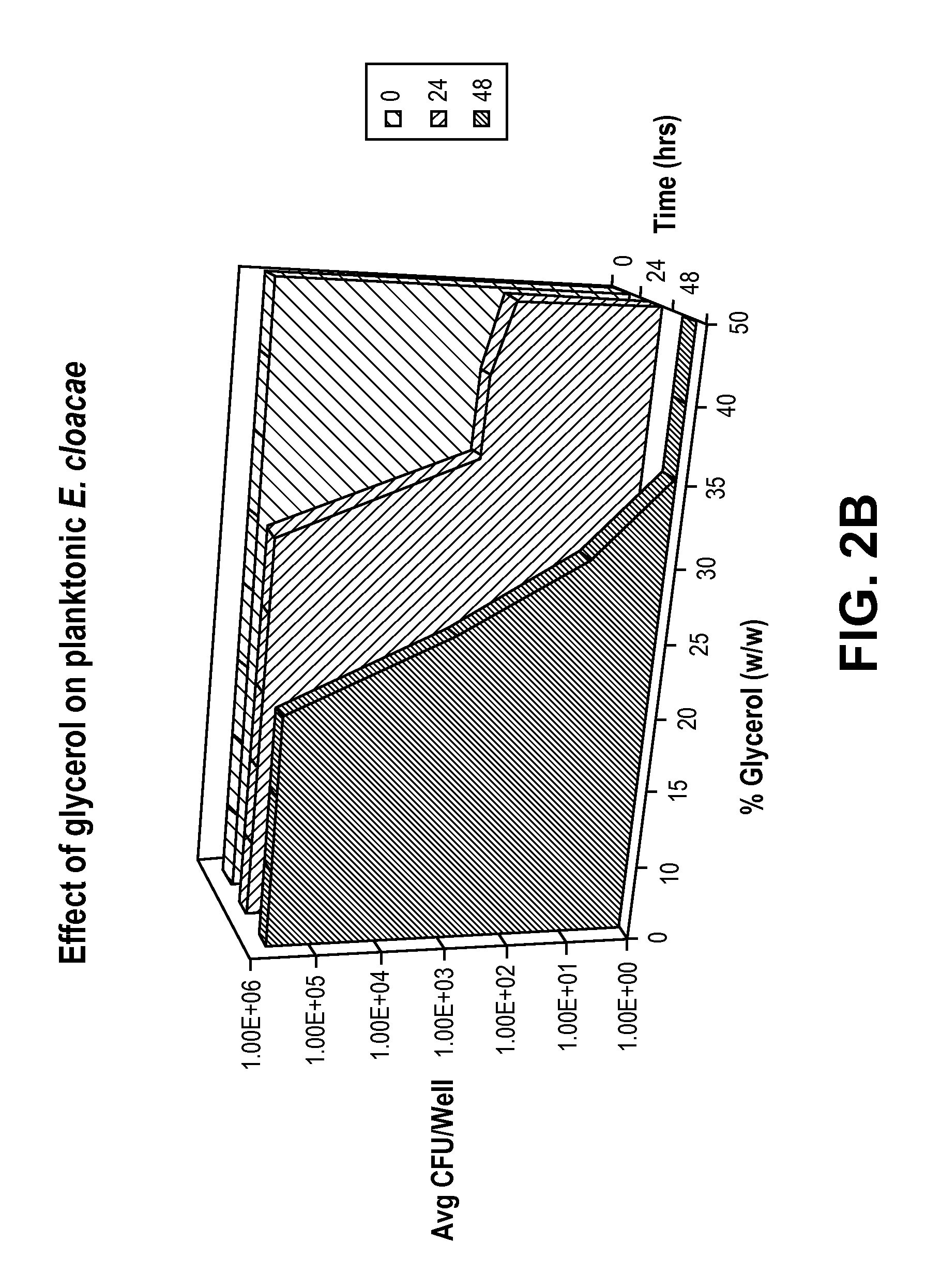Bacteriostatic Catheter Lock Containing Glycerol
- Summary
- Abstract
- Description
- Claims
- Application Information
AI Technical Summary
Benefits of technology
Problems solved by technology
Method used
Image
Examples
example 1
Preparation of Catheter Lock Solutions
[0029]Solutions containing 10%-60% glycerol (w / w) and 0.1% - 0.85% sodium chloride (NaCl, w / v) were prepared in deionized water. Effect of these solutions alone, and in combination with Heparin lock (1000 units / mL heparin from bovine intestinal mucosa, supplied by Sigma-Aldrich of St. Louis, Mo. 63103 U.S.A. (“Sigma”)) or Citrate Lock (3.8% sodium citrate) was evaluated in the hemolysis, microbiology and pro-thrombin clotting time assays.
example 2
Hemocompatibility of Catheter Lock Solution as Determined by Hemolysis Assay
[0030]Method: Human blood is collected in 3.8% sodium citrate followed by centrifugation at 800 g for 15 min. The plasma fraction is collected in a separate tube to determine the total free hemoglobin, followed by 1× dilution of the red blood cells (RBC) fraction in 0.85% saline and centrifugation at 800 g for 15 min. The top layer is discarded and the washed RBC fraction is collected for further test. An aliquot of 20 ul of the RBC is mixed in 480 ul of a test solution, incubated for 1 hour at 37° C. on a rotator at speed 3. Each test solution contains varying concentration of glycerol (10-60%) and saline (0.1-0.85%). The solution is then centrifuged at 13,000 rpm on the micro-centrifuge. A 100 ul aliquot from the supernatant is used to read the absorbance at 541 nm on a plate reader.
[0031]FIG. 1 shows the results of hemocompatibility of catheter lock solutions containing varying concentrations of glycerol ...
example 3
Antimicrobial Effect of Glycerol as Determined by “Time to Kill” Assay
[0032]The antimicrobial effect of glycerol was evaluated by testing against three common catheter-related blood stream infectious organisms: Acinetobacter baumannii ATCC 19606, Enterobacter cloacae ATCC 13047, and Pseudomonas aeruginosa ATCC 27853.
[0033]To determine the antimicrobial dose of glycerol and the time glycerol takes to kill the planktonic bacteria, solutions containing 10-50% glycerol (w / w) and 0.85% NaCl (w / v) were challenged with 1-5×105 colony forming units (CFU) / mL of planktonic bacteria. Following the challenge, bacterial growth in different solutions was monitored at time points 0, 24, and 48 hours, both by reading the absorbance at 670 nm, and by plating onto the Day Engle Agar plates and counting the number of colonies formed.
[0034]The absorbance data showed that there was no growth of bacteria in the solutions containing 30% or higher concentration of glycerol and 0.85% NaCl. Therefore, this i...
PUM
| Property | Measurement | Unit |
|---|---|---|
| Fraction | aaaaa | aaaaa |
| Fraction | aaaaa | aaaaa |
| Luminous flux | aaaaa | aaaaa |
Abstract
Description
Claims
Application Information
 Login to View More
Login to View More - R&D
- Intellectual Property
- Life Sciences
- Materials
- Tech Scout
- Unparalleled Data Quality
- Higher Quality Content
- 60% Fewer Hallucinations
Browse by: Latest US Patents, China's latest patents, Technical Efficacy Thesaurus, Application Domain, Technology Topic, Popular Technical Reports.
© 2025 PatSnap. All rights reserved.Legal|Privacy policy|Modern Slavery Act Transparency Statement|Sitemap|About US| Contact US: help@patsnap.com



